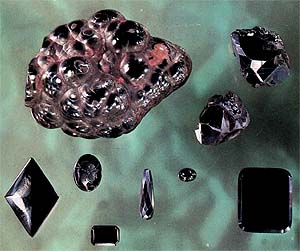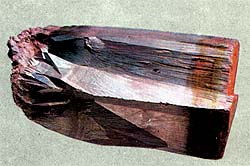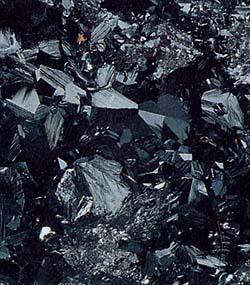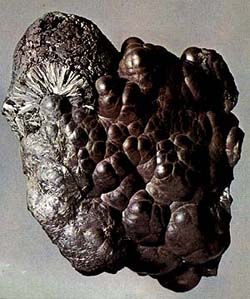Stone, minerals and semiprecious of the world stone
Oxide and hydrooxide: Hematite, Anhydroferrite (blood-stone) -->rus
 Diagnostic cart.
Diagnostic cart.
There are kidney-shaped reniform aggregates on a photo (Egremont, Kamberlend, Great Britain). Down: crystals of anhydroferrite, which are known as a "haematite".
Fe2 O3
Crystal structure trigonal
Hardness on the Mohs scale 6,5
Specific unit weight mass 5,2-5,3
Cleavage non-existent
Fracture, break padman
Colors from red to black
Colors in powder triturate brown-red
Glance (glitter, glare) metallic

 The names of iron-stones are formed on their belonging to one or another class of compounds (oxide, silicate, sulfide) or on mineral composition (hematite, limonite). Hematite as crystals named a haematite, short-grained aggregates - red ironstone. A Hematite (Anhydroferrite, oxide gland), hardness 6,5-6. Glance (glitter, glare) metallic, is opaque. Colors greyish-black with pied oxide tint. A line is red. Fracture, break padman. Cleavage non-existent. The forms of crystals, belongings to trigonal Crystal structure, are very various.
The names of iron-stones are formed on their belonging to one or another class of compounds (oxide, silicate, sulfide) or on mineral composition (hematite, limonite). Hematite as crystals named a haematite, short-grained aggregates - red ironstone. A Hematite (Anhydroferrite, oxide gland), hardness 6,5-6. Glance (glitter, glare) metallic, is opaque. Colors greyish-black with pied oxide tint. A line is red. Fracture, break padman. Cleavage non-existent. The forms of crystals, belongings to trigonal Crystal structure, are very various.
Red ironstone: a color grey-стальной with a red tint. Presented dense grainy or radiant aggregates. Pochkovidnye excretions, consisting of thin-лучистых individuals and covered a brilliant reddish crust, name a "red glass head". Especially dense varieties - blood-stone - polish and engrave for decorations. Powder from pounded кровавика is used for the polish of gold wares.
Earthy variety - a reddle does not have a metalloid type and used as dye. Hematite ore meet in the metamorphic layers of ferrous quartzites as continuous beds and in ore vein, lode, mines, and also in form "ferrous mica" - in skarn. Deposit minefield mine field occurrence subsoil: in Canada, USA, Brazil, CIS.

Hematite, Slavonic district, Donbass, southeast of Ukraine, CIS.
Album of photo, Donbass, minerals (on January, 27, 2013, 09:40).
At treatment an anhydroferrite paints cooling water in a blood-red color, from here his name (from Greek. haima is blood) and synonym for a dense variety - blood-stone. The brilliant lamellar tabular crystals of anhydroferrite name specularite (from Greek. specula is contemplation) - in antiquity they were used as mirrors. In mineralogy well well-educated crystals name a "haematite", and fine-grained aggregates - "red ironstone". In thin leaves an anhydroferrite transparent red, in the polished kind has bright, living brilliance.
At treatment an anhydroferrite paints cooling water in a blood-red color, from here his name (from Greek. haima is blood) and synonym for a dense variety - blood-stone. The brilliant lamellar tabular crystals of anhydroferrite name specularite (from Greek. specula is contemplation) - in antiquity they were used as mirrors. In mineralogy well well-educated crystals name a "haematite", and fine-grained aggregates - "red ironstone". In thin leaves an anhydroferrite transparent red, in the polished kind has bright, living brilliance.
 Hematite - mineral of black, often with an iridescent reflection, crystallized in trigonal Crystal structure. Often crystals of oblate form ("haematite or oligiste"), or lamellar tabular and located like petals roses ("ferrous rose"). Be found in the type of either more or less dense the masses, sometimes with an iridescent reflection on-the-spot or earthy accumulations of the red colouring. In last case it is named red ironstone. Can also have oolitic addition or form concretions.
Hematite - mineral of black, often with an iridescent reflection, crystallized in trigonal Crystal structure. Often crystals of oblate form ("haematite or oligiste"), or lamellar tabular and located like petals roses ("ferrous rose"). Be found in the type of either more or less dense the masses, sometimes with an iridescent reflection on-the-spot or earthy accumulations of the red colouring. In last case it is named red ironstone. Can also have oolitic addition or form concretions.
Glance (glitter, glare) metallic. Hard, does not scratch a knife-blade, but quartz scratches, Apatite scratches. Hematite as heavy as lead, does not have cleavage, fragile frail brittle.
Diagnostic indication.
Hematite is heat-resistant and at heating acquires magnetic properties. Colors in powder triturate dark-red, that distinguishes him from other oxides of iron (magnetite and ilmenite). Entangling an anhydroferrite is possible with a dark tinstone. Imitations sometimes make out of the pressed and sintered Hematite wreckages (ceramics).
Origin provenance genesis.
This mineral is ordinary in effusive rocks, in pegmatites and in hydrothermal vein, lode, mines, appearing at formation of granites and pegmatites. Very often has a sedimentary origin, formed at partial recrystallization (diagenesis) of swamp ore. In parallel instances an anhydroferrite can have oolitic or concretionary addition.
Forms pseudomorphosis on magnetite. At that rate it is named martite. Material, suitable for treatment, be found in Kamberlende (England), in Tyuringii (Germany), on Elba, and also in Norway, Sweden, Spain, Brazil, New Zeland, USA, CIS (Kazakhstan).
 Deposit minefield mine field occurrence subsoil.
Deposit minefield mine field occurrence subsoil.
Deposits, related to the ferrous quartzites, are most essential from point of the industrial mastering (takonite). The largest from them - Leyk-syuperior (USA), Quebec (Canada), and also deposits of Venezuela and Angola. Deposit found out minefield mine field occurrence subsoil of oolitic type in Canada, in the state of Tennesi (USA) and on Ukraine.
In Italy beautiful forms of "haematite" are in Rio-Marina (an island Elba), and also in Brazil, state of Baya, and also in Great Britain in Kamberlende. The most famous "ferrous roses" acted from the group of Gotard in Val'-di-binn (Switzerland). But most large from them, measuring in a diameter to 15 sm, take a place from the state of Minas-zherays (Brazil).
In Brazil there is another variety, strongly oblate, with a quite mirror surface, getting the name of specularite. Very beautiful matrite is found in Canada and United States (USA), in Tvin-piks (state of Quarter-deck) and in the district of lake Overhead.
Use, practical application, deployment.
In spite of not too high maintenance of iron, anhydroferrite - one of the most important ores of iron, that is conditioned his wide distribution. Red ironstone is used as a pigment, also apply as polishing powder. Although on jeweller business an anhydroferrite is not in large demand, him from ancient times (especially dense massive microcrystalline form with remarkable brilliance) used for decorations. Finds application use in decorations, used for insertions in finger-rings, round beads and as material for the sunken engraving (intaglios).
Oxide and hydrooxide: Romaneshit
 Diagnostic cart.
Diagnostic cart.
Mn5 O10 * (Ba, H2O)
Hardness on the Mohs scale 4-6
Specific unit weight mass 4,4-4,7
Cleavage non-existent
Colors black
Colors in powder triturate brown-black
Glance (glitter, glare) semimetallic or dim
Romaneshit is a barium containing hydroxide of manganese, outwardly look like an anhydroferrite "red head". Glance (glitter, glare) semimetallic or dim. Opaque. Colors black. A line is brown-black. Fracture, break padman, fragile. Cleavage non-existent. Appears in basic sediments deposits.
Amorphous or cryptocrystalline, botryoidal composes, kidney-shaped reniform formations ("black glass head"), there is earthy (wad), pellicle dendrites forms. Important ore of manganese. Among other manganese ore minerals it should be noted Polianite, pirolusite, Manganite, hausmannite, braunite, cryptomelane.
Deposit minefield mine field occurrence subsoil.
Deposit minefield mine field occurrence subsoil: in the CIS, Ghana, Congo, Republic of South Africa, India. A standard on a photo is a classic "black glass head" from Vesterval'da, Gessen, Germany.
